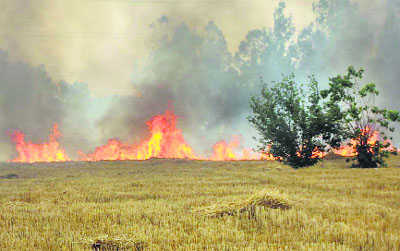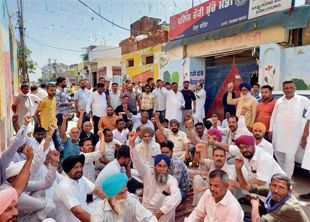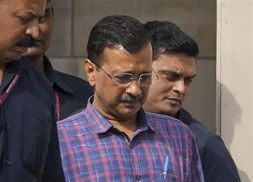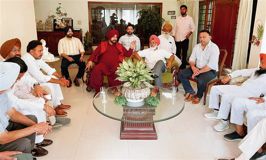
Pollution rises many times by burning paddy stubble, what would bombing cities do? Tribune photo
Ali Ahmed
G. Parthasarathy's article in The Tribune (November 19) argues that, “Pakistan should be presented a stark picture of what would happen to its Punjab province, if it resorts foolishly to nuclear adventurism, whether tactical or strategic.” He prefers that India respond to any Pakistani use of nuclear weapons, including tactical nuclear weapons, with “massive” nuclear retaliation in keeping with India's declaratory nuclear doctrine. To him, holding densely populated Pakistani Punjab hostage would deter Pakistan from going nuclear.
He is not alone in holding such a position. Ambassador Shyam Saran also made the same point in his Subbu Forum Society lecture in New Delhi in 2013, when he was Chair of the National Security Advisory Board. Saran said, “If it (India) is attacked with such weapons, it would engage in nuclear retaliation which will be massive and designed to inflict unacceptable damage on the adversary… the label on a nuclear weapon used for attacking India, strategic or tactical, is irrelevant.”
That India continues with its declaratory nuclear doctrine that dates to 2003 implies that it is a widely held view. The prospects of near-certain destruction can only serve to deter. Since 2003, much water has flown down the Indus. The subcontinent has witnessed vertical proliferation, with Pakistan reputedly having 140-160 nuclear warheads. India is not far behind. What this suggests is that Pakistan has the capability to retaliate in kind in case India was to massively counter Pakistan's introduction of nuclear weapons into a conflict. Since India stands to be grievously hurt, it may be unwilling to follow through on its promise of “massive” nuclear retaliation.
This may embolden Pakistan to go nuclear. Consequently, India would do well to arrive at safer options. Parthasarathy points to Pakistani Punjab as offering plentitude of nuclear targets for retaliation even if Pakistan's nuclear first use only targets Indian troops operating under its “Cold Start” doctrine. If India targets west Punjab, then its own border areas in proximity starting from Rajouri, through Jammu and onwards via Amritsar down to Ganganagar stand to be affected by direct and long-term environmental consequences. Even areas further away will not be spared. Burning of paddy stubble in fields in Punjab invariably chokes Delhi with its pollution. On Diwali, the figures for pollution in Delhi were 23 times WHO's permissible limit. It can only be imagined what the environmental fallout from the burning of even a couple cities would entail.There would also be a socio-political fallout. The ongoing refugee crisis in Europe suggests multiple dangers. Population movements will be akin to those at Partition. These will not necessarily be towards the west since across the Indus begin deserts. Afghanistan is an unlikely prospect as a destination. India may well be where these flows will head. The refugees in Europe today are unlikely to go back soon. Similarly, those who gatecrash India's border fence will be here for the long term. As the Paris attacks show, their influx will not be without dangers.
They would be in addition to India's own border populace who would likely have fled inwards. This is in addition to the internally displaced people India may have to cope with in case any of its cities are hit in counter retaliation. Many would flee cities such as Delhi, fearing such targeting. The civil administration that at the best of times finds coping with monsoon difficult will be unable to rely on the military to bail it out. The military will be busy inside Pakistan. A proportion of the paramilitary have relieved the Army to stanch possible resurgence of insurgency in Kashmir. There are also imponderables such as effects of the contrived identification of Indian Muslims with Pakistan. The latest manifestation of this was in the BJP president saying that in case the party loses in Bihar, there would be celebrations in Pakistan. Some have interpreted the reference to Pakistan to mean a reference to India's internal “other”, its Muslims. Given extant conditions of polarisation, it is not impossible to visualise a communal carnage within India in case of war going nuclear with its largest minority as a scapegoat.
Clearly, with such scenarios easy to visualise, it is strange that India persists with the logic of 'massive' nuclear retaliation. Pakistan will unlikely be deterred by this formulation, knowing India cannot follow through. Consequently, India needs to reframe its nuclear doctrine, moving away from “massive” to a more credible “tit for tat”. Such exchange(s), albeit avoidable, will yet keep Indian cities safe. The rumours of impending nuclear doctrine revision that attended the BJP election campaign last year must be taken to the logical conclusion in a revised nuclear doctrine. The revised one must be predicated on preserving India from nuclear damage to the greatest extent possible; feasible only by a “city avoidance” strategy in first place.
Ali Ahmed is author of “India's Doctrine Puzzle: Limiting War in South Asia.”



























